
Tri-Cities Historical Museum ~ Grand Haven, MI
Grand Haven, Michigan is a charming, quaint, coastal community that sits along the shores of Lake Michigan. Our families have many fond memories of its beaches, lighthouse, annual Coast Guard Festival and the Musical Fountain.
This post may contain affiliate links and we may earn compensation when you click on the links at no additional cost to you.
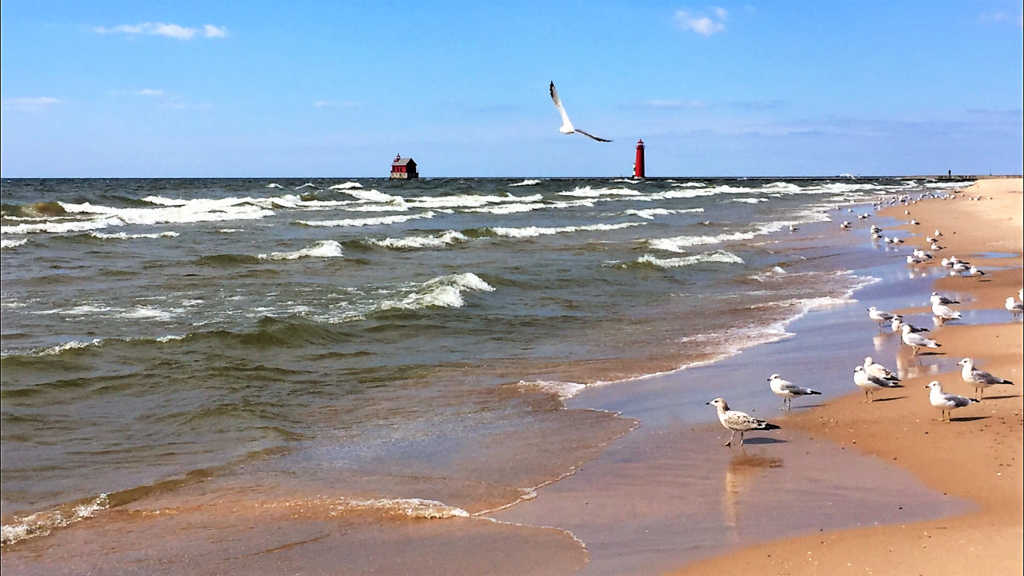
Last summer, we discovered a new favorite place to add to our memories of Grand Haven… the Tri- Cities Historical Museum! Located in the heart of historic downtown, and within walking distance to the beach, this hands-on history lesson has something for everyone.
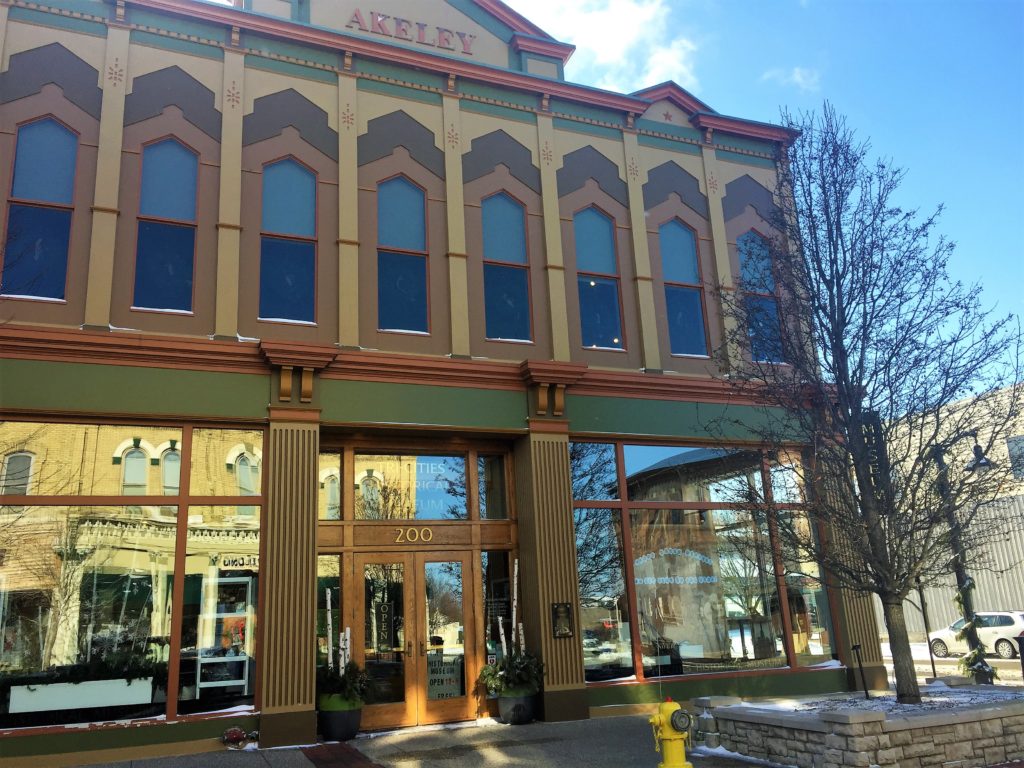
Inside, you will find a chronological walk-through of the history of the Grand Haven area complete with a wigwam, log cabin, Victorian parlor and a hometown grocery store from 1895. There are so many interesting artifacts, many of which you can actually touch.
Tri-Cities Historical Museum has done an outstanding job making history fun and engaging for all ages. We fell in love with this adorable museum and are happy to share our experience with you.
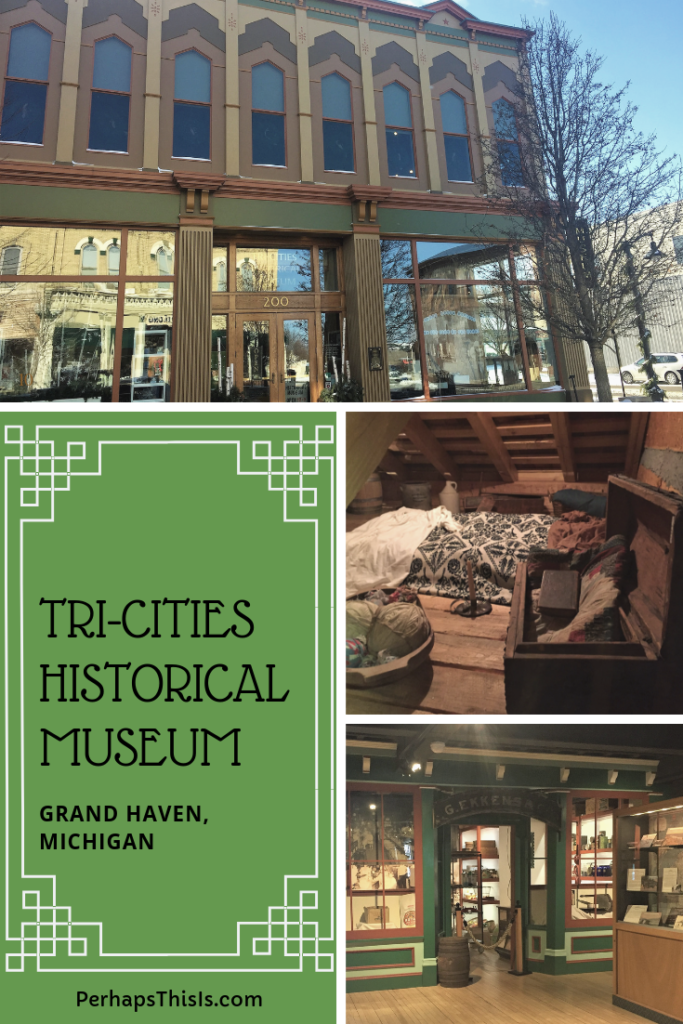
A huge thank you to my dad, Ron, for sharing his photos from our visit for this post… apparently I was too engaged with my surroundings to remember to take some to share outside the family! Way to go, Dad!
A Peek Into the Past
I can’t start without first saying that if you have a daughter who loves the historical American Girl dolls, this is the place for you! At Tri- Cities Museum, you will step back in time to settings that are similar to Kaya, Kirsten Larson and Samantha Parkington. From the handmade Native American items to the heavy, formal feeling of a Victorian home, you really get a sense of how each character might’ve lived.
Also, when we visited, we happened to be in the middle of reading Little House in the Big Woods. The log cabin at the museum was fantastic for allowing my kids to pick up and hold items similar to what we’d read about in the book. Items such as a rifle like Pa may have had, a heavy cast iron cooking kettle with legs or a yoke used to carry buckets of water over your shoulders.
Tri-Cities Historical Museum was such a great, unexpected resource for us while reading The Little House on the Prairie series and for getting to know Kaya, Kirsten and Samantha. I’m certain we will visit again, and next time my daughter will be bringing her Kaya doll.
Native American Life and the Fur Trade
The Ottawa, Chippewa and Potawatomie were the first people to live on the land that is now Grand Haven. They knew the land well and had to provide everything for themselves.
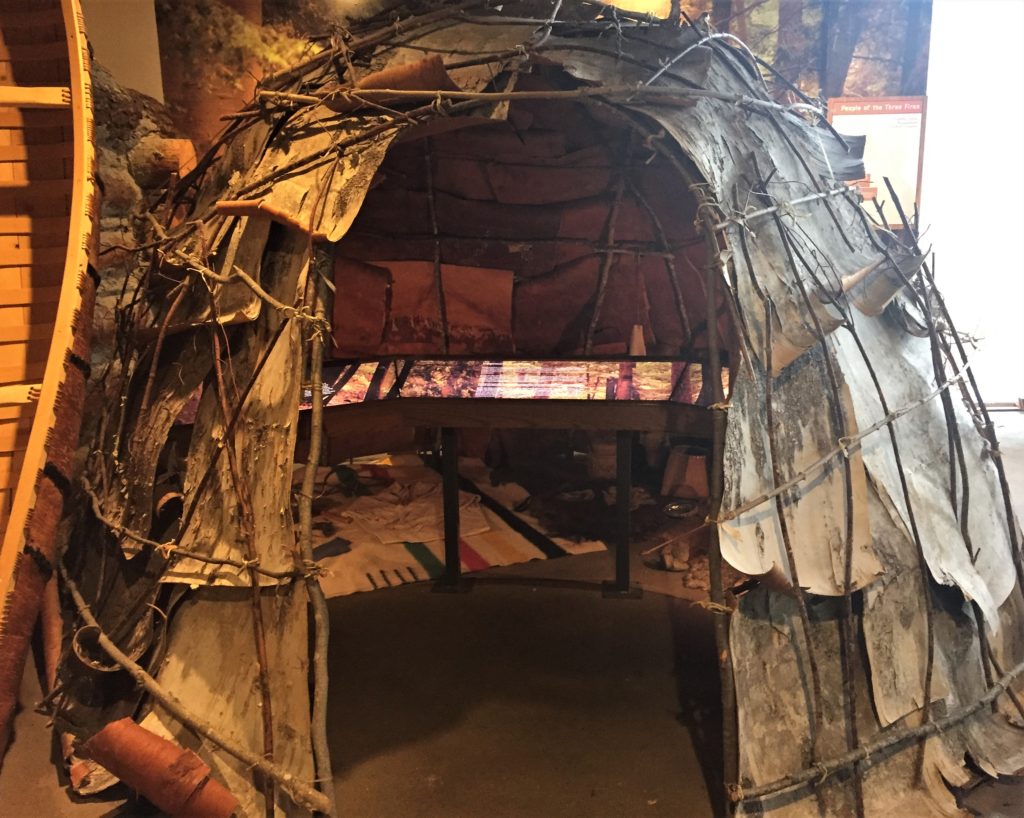
Everyday items, that are taken for granted nowadays, had to be handmade and made to last. Nothing went to waste. The detail, craftsmanship and sense of pride in each item is truly amazing. There is even a birchbark canoe next to the wigwam!
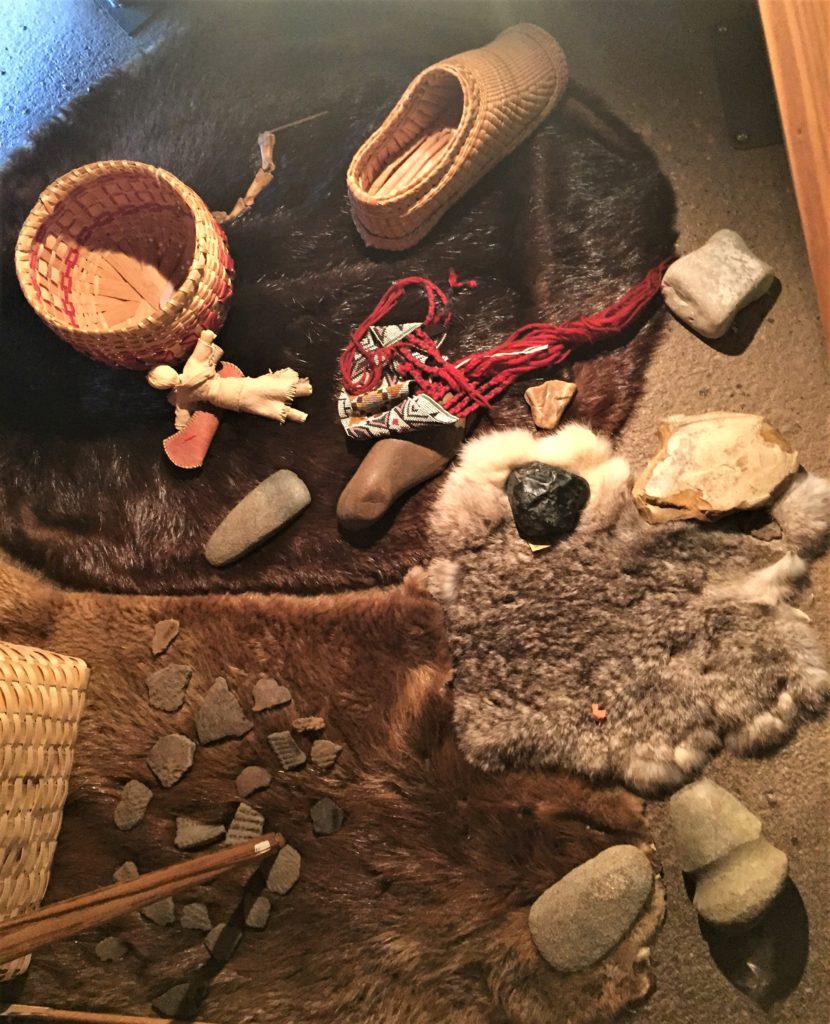
Fur Traders Post
Life for the Native Americans changed quite a bit with the arrival of fur traders and settlers from Europe. Fur trading became the first major industry in Michigan and with it came new weapons, tools and even clothing.
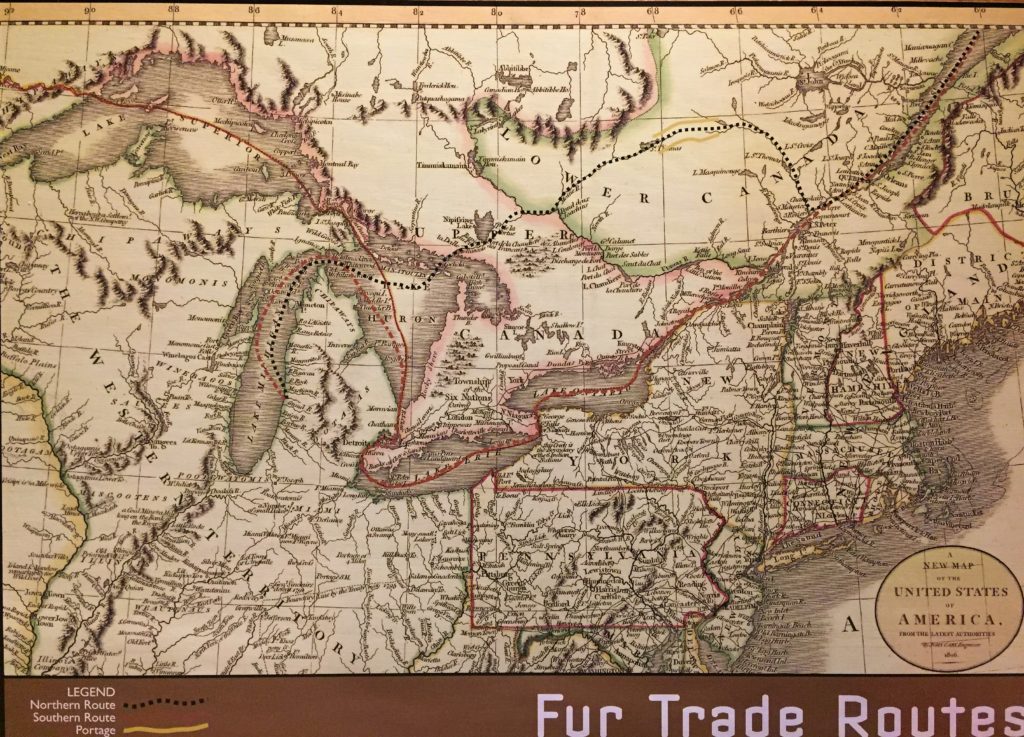
The trading post contains a variety of hands-on items that will help you understand the many changes that took place during this time. Metal cookware, cotton/wool clothing and even guns were all new to the Native Americans.
Inside the trading post, there are also examples of some of the supplies needed for the dangerous journey to trap and trade the furs.
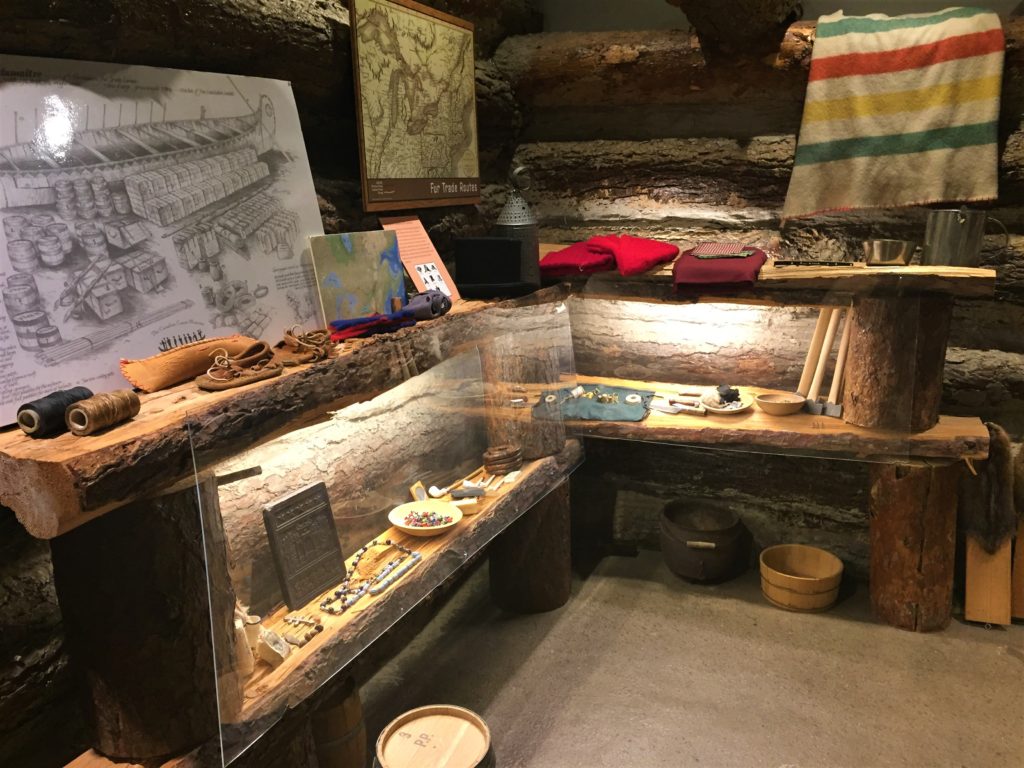
Pioneer Cabin
Our favorite exhibit was the replica pioneer cabin. We immediately thought of the Ingalls family and American Girl, Kirsten Larson!
Pioneers had to provide just about everything for themselves, and this cabin is full of all kinds of things to show you just how they did. The exterior looks like a log cabin, so you feel as if you are actually entering one, rather than an exhibit room.
To see the log cabin, and other structures inside the museum, be sure to check out their virtual tour.
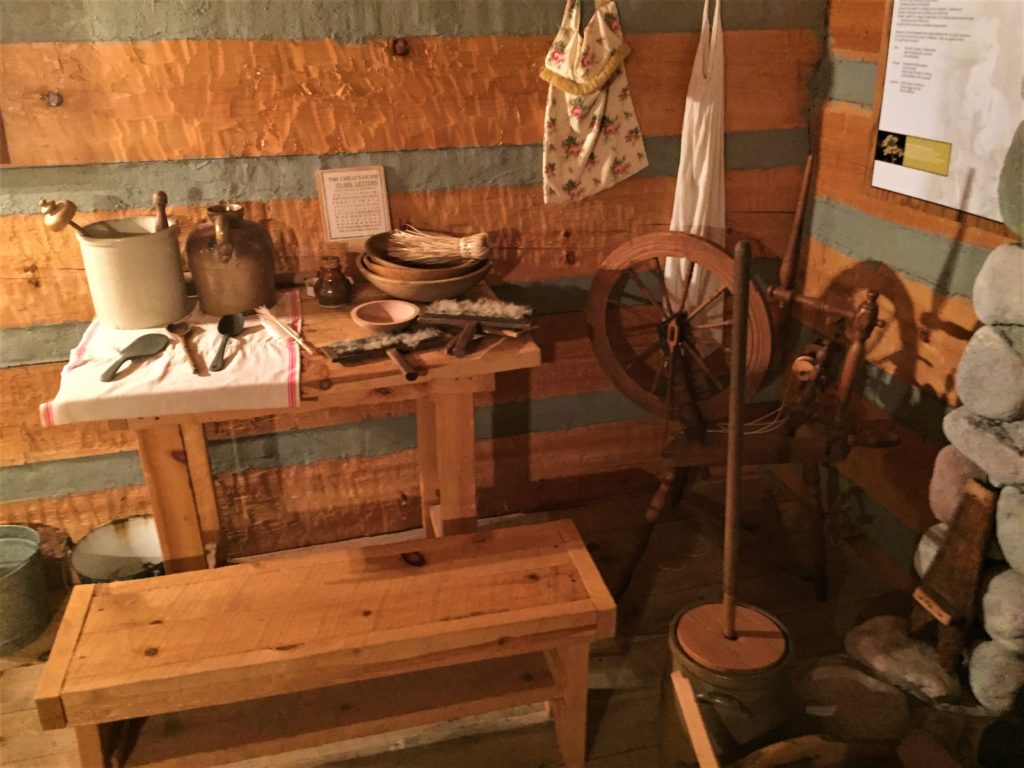
Once inside, everything looks and feels old and you can even smell the timbers that were used to make the cabin. The best part… anything not behind glass you are able to touch! This was SO fun for us because many of the items we had just read about in the Little House on the Prairie series.
We were able to pick up a cast iron kettle with spider legs to feel just how heavy it was. My kids were pretty surprised by the weight! We held a rifle, like Pa may have used, and even tried on a heavy wooden yoke that is used to carry water. I loved the hand-dipped candles that hung on the fireplace mantle, which brought back my memories of making some as a child.
We definitely got a sense of how difficult everyday chores were for the pioneers. Being able to hold items made such an impact on my kids.
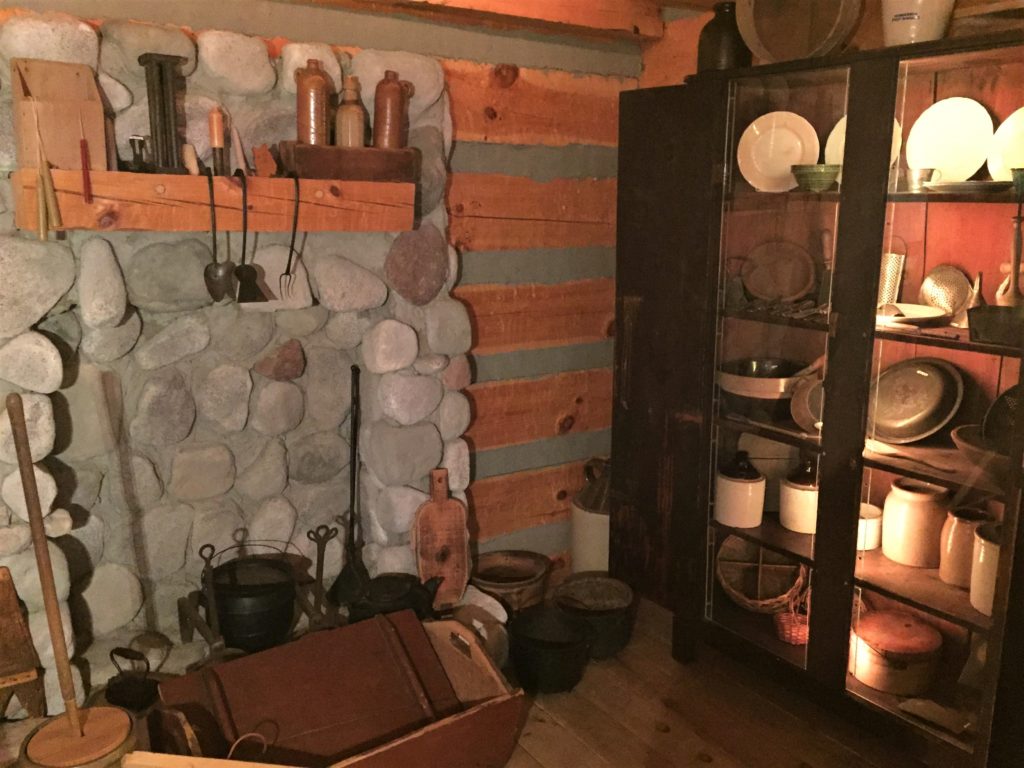
Outside the cabin is a stairwell to get to the upper level displays. As you pass by, there is a cutout in the cabin’s roof that reveals a cozy bedroom. Although quite rustic, after a long day’s work, this looks like just the place to get some rest.
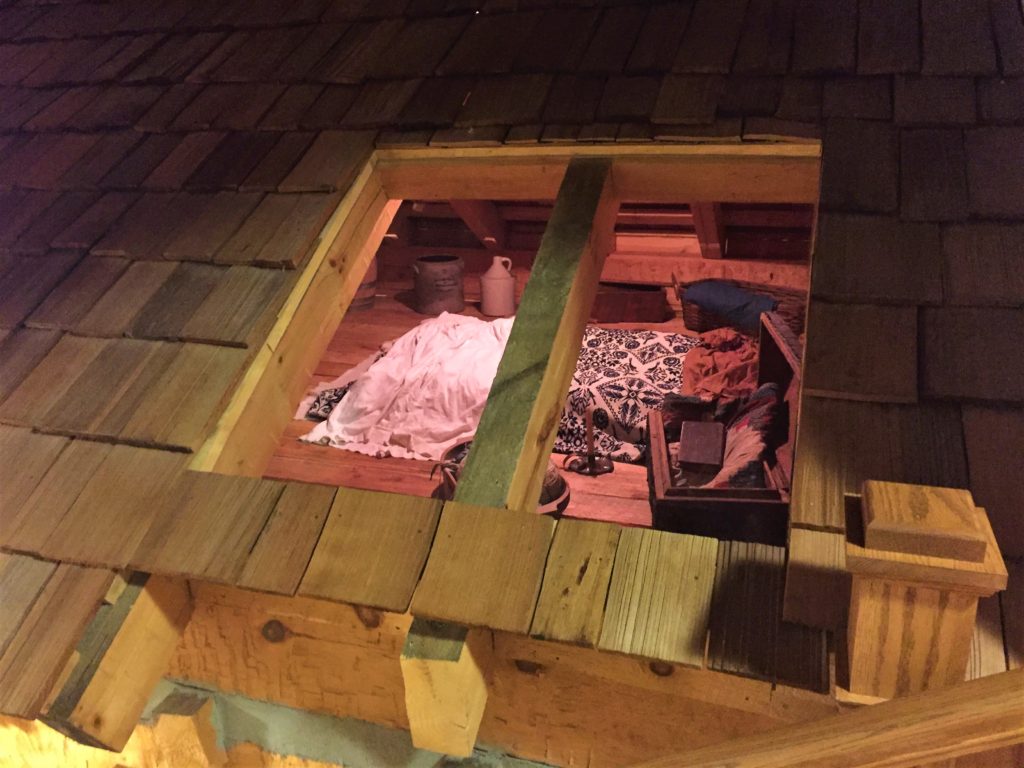
We had learned in the Little House on the Prairie series that the Ingalls family used the upper level of the cabin for food storage to get through the winter, and slept on the main level. My kids were quick to point out the difference!
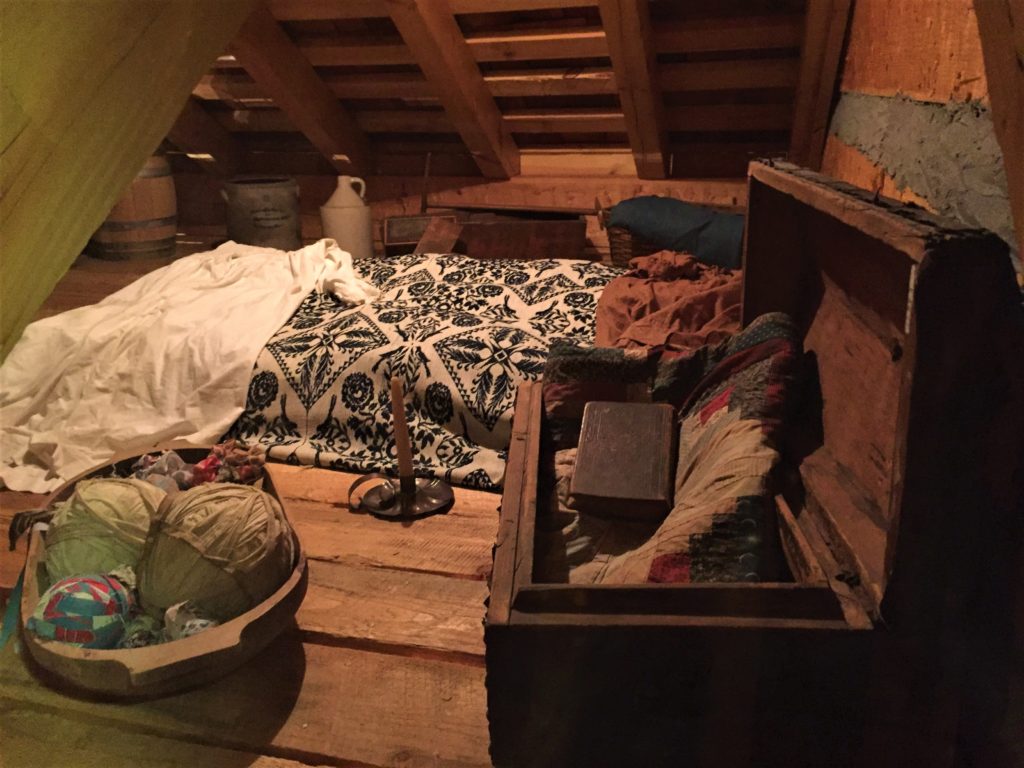
As you may’ve guessed, we went up and down the stairs quite a bit to get “one more” look inside.
Logging Camp
Michigan has a lot of trees, so it is no surprise that the logging industry once flourished here. By the 1880’s, Michigan was actually the top lumber producer in the United States. White Pine trees, which grow straight and tall, and are easy to work with, were on the “most wanted” list for logging companies…. and Michigan had tons of them.
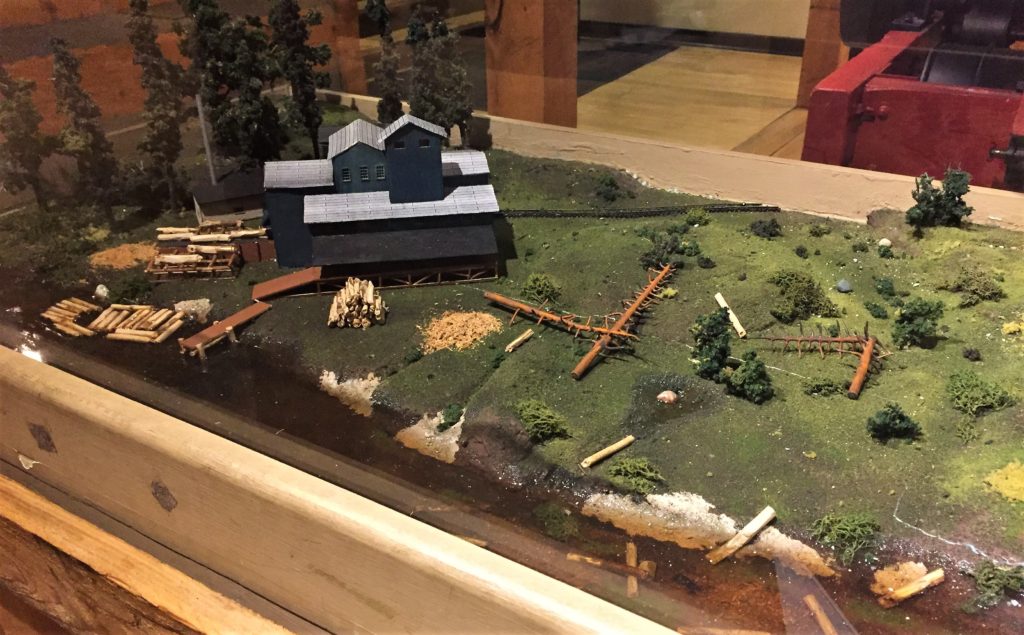
Life for the loggers was hard because logging was usually done during the winter months. The cut trees were easier to move on sleds (pulled by horses) over the frozen ice and snow. The logs were taken to the edge of a riverbank and left until they could be floated down the river in the spring for processing.
Cutting down all those trees took a lot of workers. Bunkhouses were built for them to live in and some could sleep up to 100 people! After working 12-14 hours a day, you could expect a sleepover every night with your co-workers. Yikes! The bunkhouse replica gave us an idea of how the loggers lived, and trust us, the wooden beds do not look comfortable. Not to mention, an actual bunkhouse would’ve been dark, drab and muddy from the winter snow trekked in.
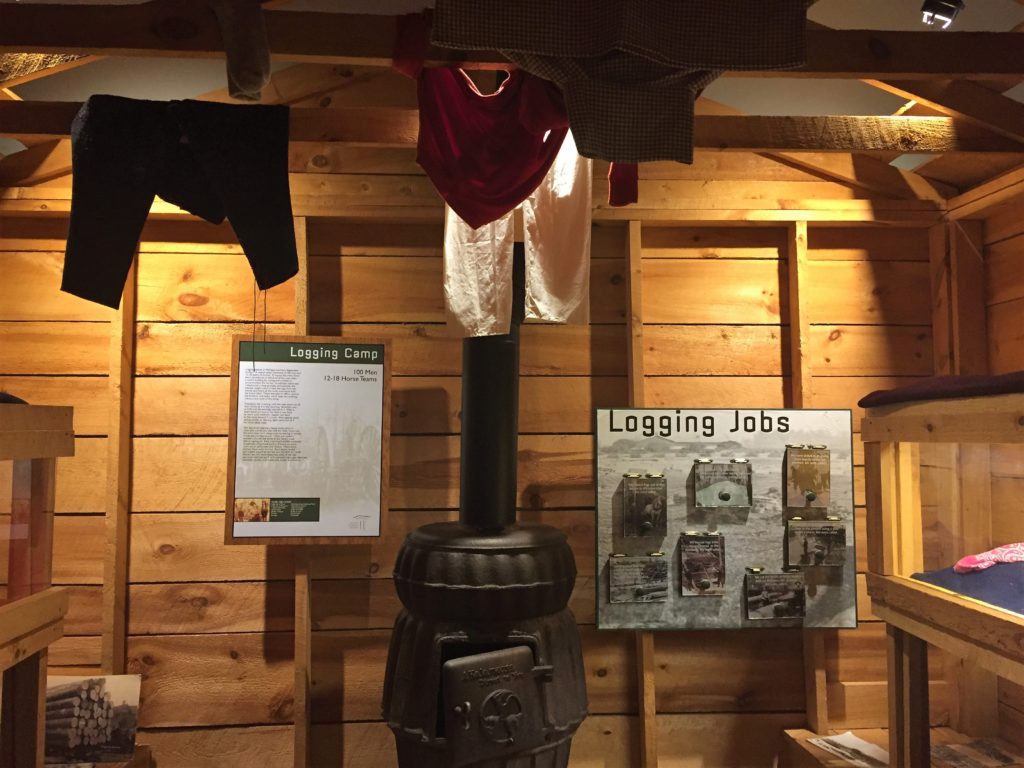
Cutting down and processing the trees required a variety of tools and equipment, a lot of which were hand operated. Logging was very labor intensive. The size of some of the hand saws was incredible and they looked pretty heavy, too. I definitely would not have been a good logger!
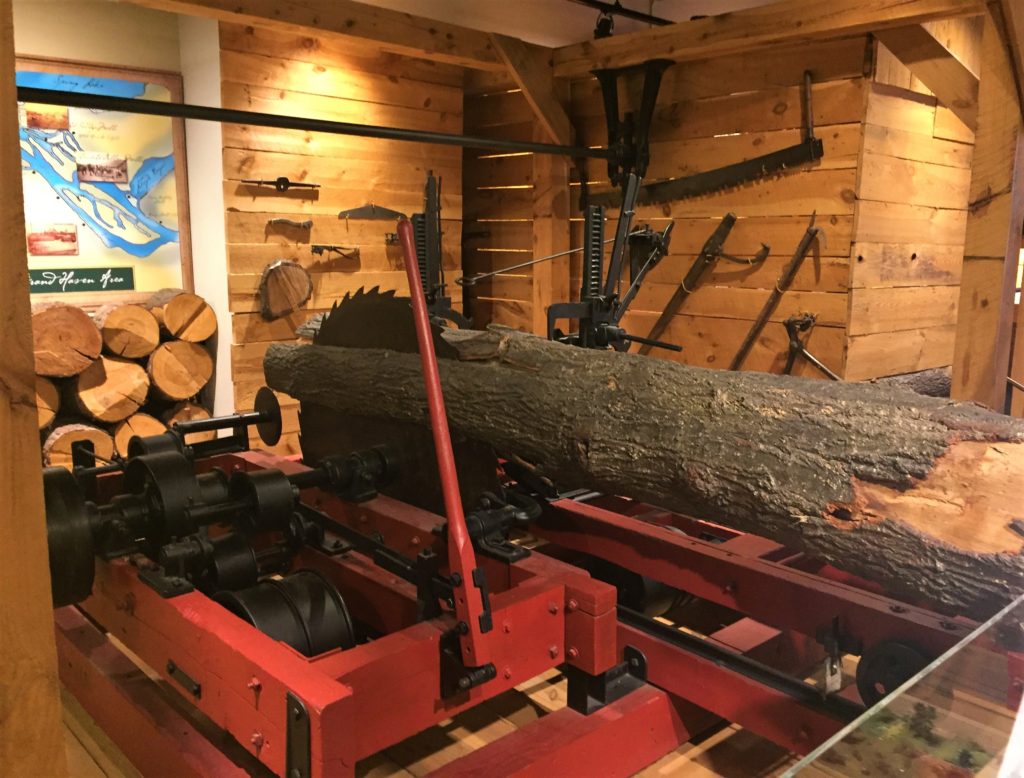
The blade on the cutting machine was massive and I imagine the sound was overwhelming as it cut through the thick trunks.
Living the Victorian Life
A far cry from the accommodations at the logging bunkhouses were the stately Victorian homes that were lavishly decorated. Everything is behind railings here (lots of breakables!), so it is only looking at the items done here. It was easy for me to imagine how difficult life with a curious toddler must have been during Victorian times.
Because we visited in October, the rooms were adorned with Halloween decorations from the time period. Before seeing this it never occurred to me that Victorians celebrated Halloween, too. It is my favorite!
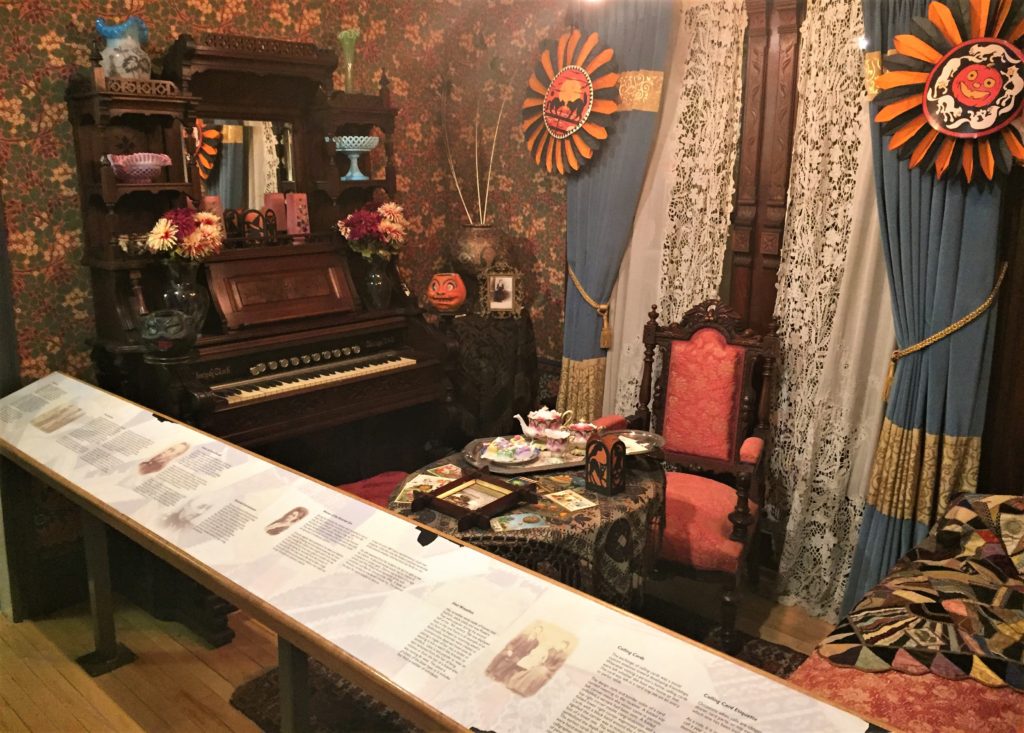
Elaborate sideboards full of glassware and china surround the table in the dining room. This was a very formal feeling room and it looked like it was all set for a Halloween dinner. There was even a Victorian Ouija board set up for guests (those have always freaked me out).
The Ouiji board wasn’t the only thing that had me shuddering. Yet again, the thought of raising a toddler came to my mind, but this time feeding one (squirming of course!) while using the fancy dinnerware. Eek!
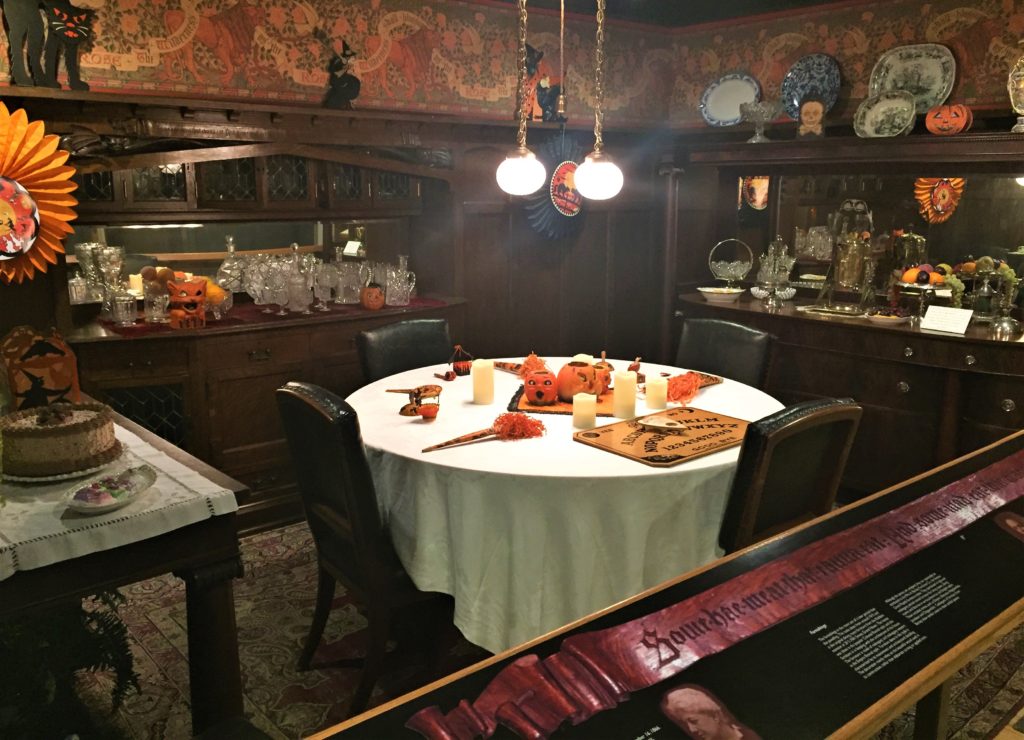
The kitchen was pretty cozy and seemed modest compared to the dining room we’d just left. There were lots of Victorian food packages and fake produce scattered throughout. The table was set with ingredients to make an apple pie. We found the ice-box, to the left of the window, quite interesting. At first glance, it appears to be a cabinet and is much different from the stainless steel refrigerators we are used to seeing today.
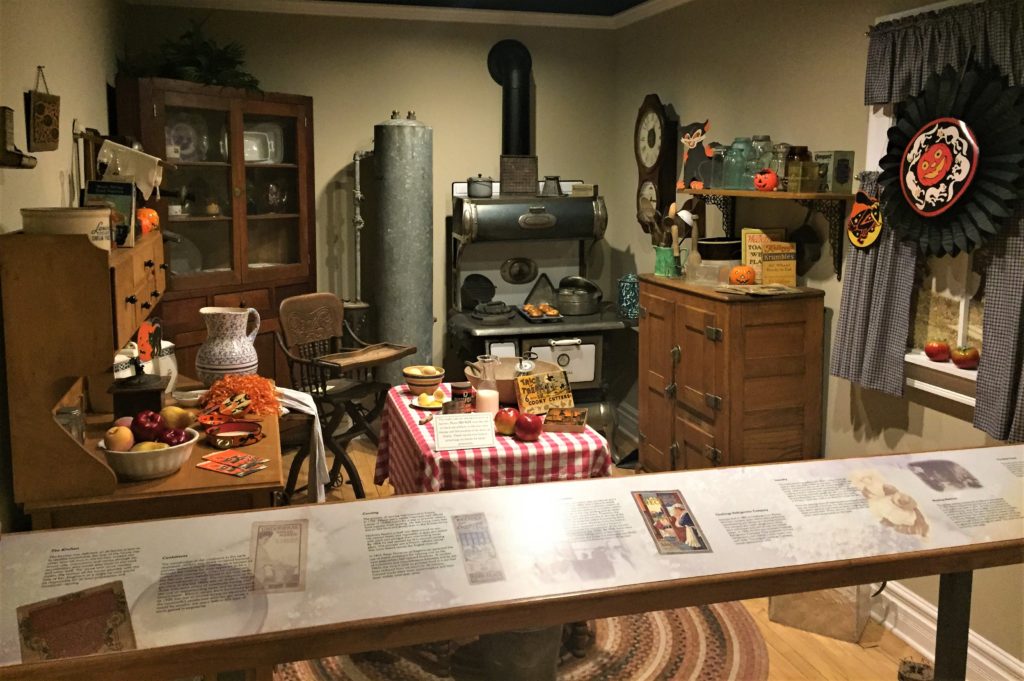
We also really enjoyed Ekken’s Grocery Store, a replica of a shop from 1895. Old shops get us every time! There is something almost magical about peeking in the windows of a grocery store from the past.
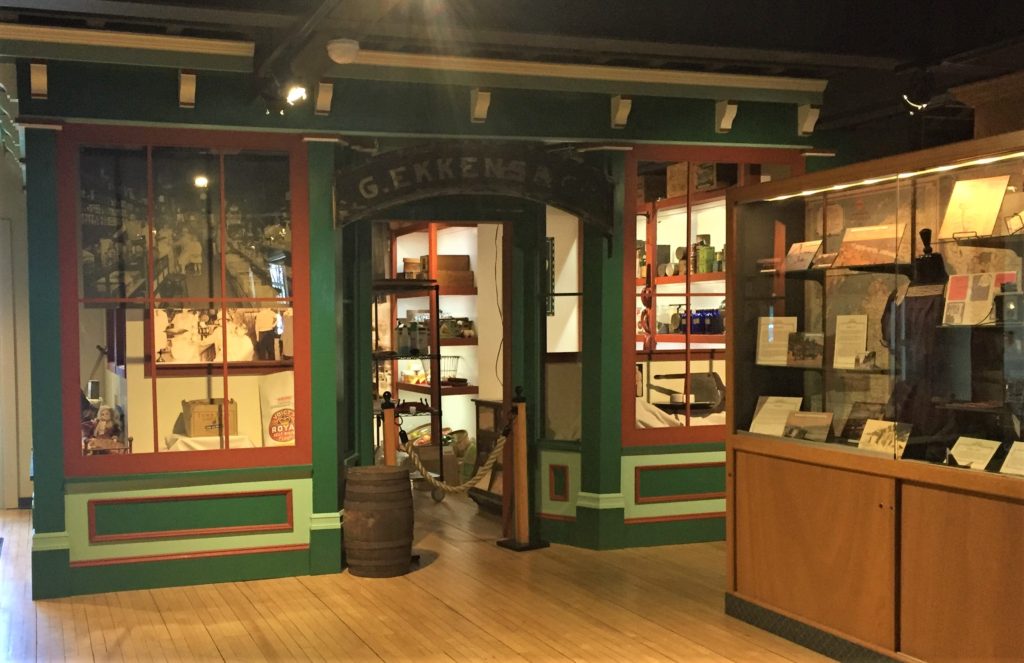
Ekken’s has everything from pantry items, to household goods and even toys and games. The produce section was realistic, colorful and my favorite part. You could almost smell the garden goodies! And look… no plastic packaging.
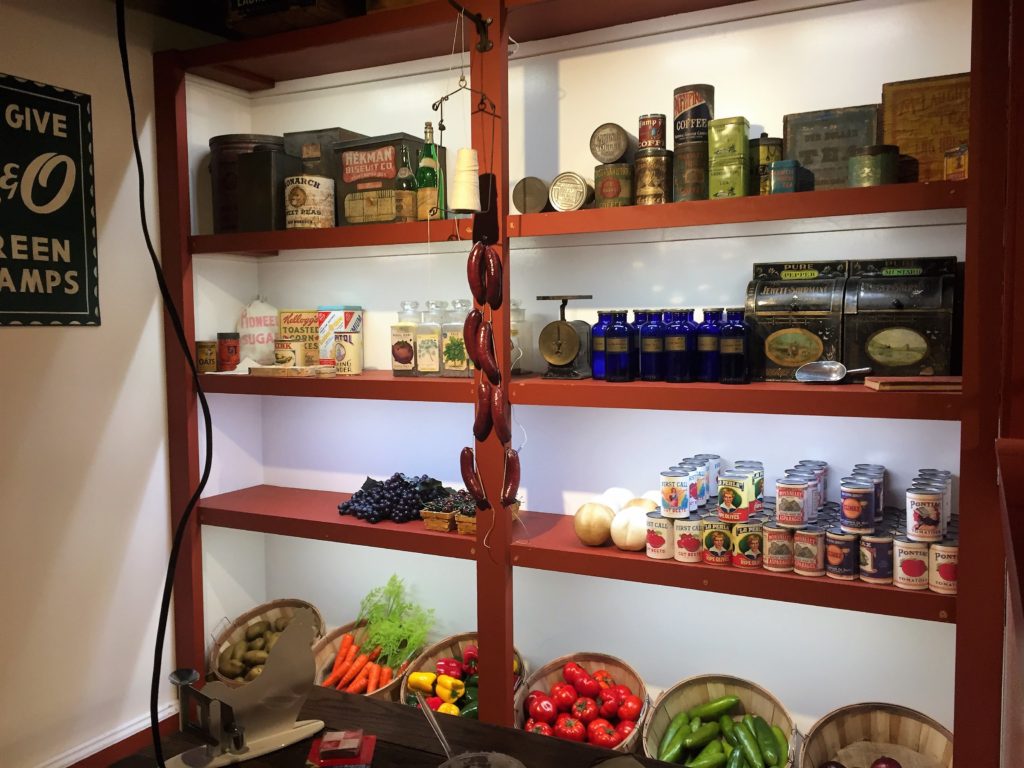
I highly recommend slowing down to browse at Ekken’s Grocery Store to experience the simplicity of shopping before big box stores and shopping carts.
There is More Upstairs!
Once you’ve explored the lower level, there is still more waiting to be discovered upstairs. The upper level has space for rotating exhibits, as well as some permanent ones such as, a look at medical equipment from the past 100 years and a 1950’s soda fountain that was produced by local manufacturer, Bastian and Blessing.
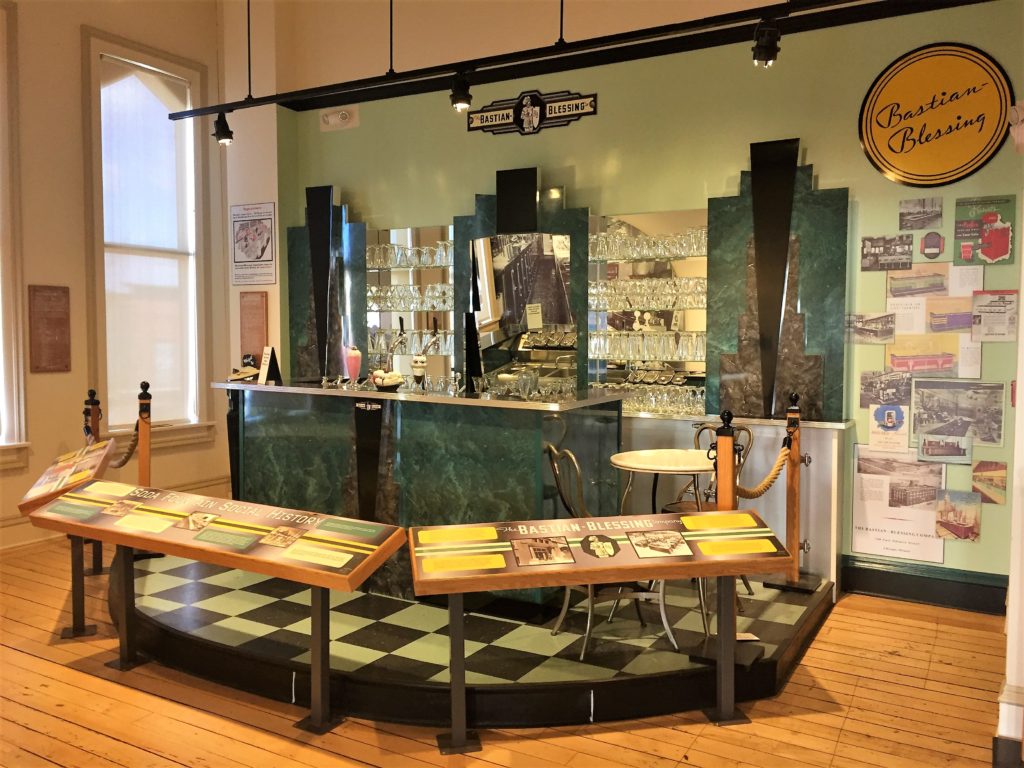
When we visited there was a rotating exhibit on display which held a collection of artifacts from World War I. The items told the stories of soldiers who were from the Grand Haven area that served our country. Helmets, uniforms, rifles and letters all told the story of the many sacrifices and dangers they endured.
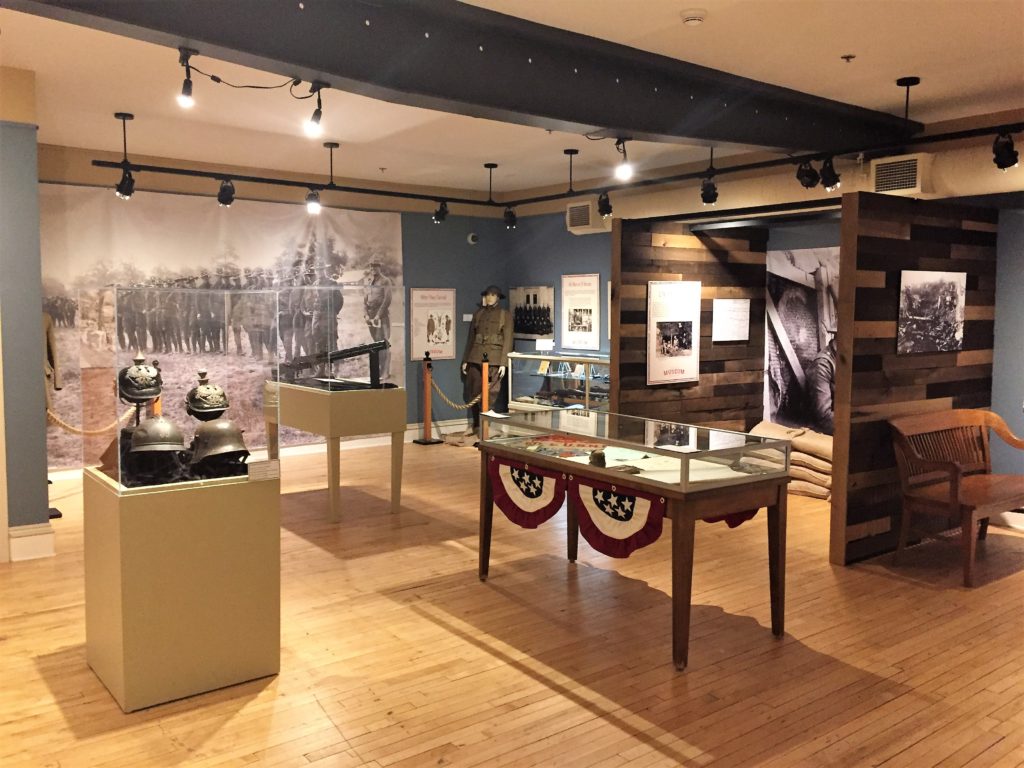
Currently occupying the rotating exhibit space (Jan. 2019 – Sept. 2019) is Icebound: The Ordeal of the S.S. Michigan on loan from the Historic Ottawa Beach Society. In 1885, shortly after embarking on a rescue mission, the S.S. Michigan became trapped in ice, where it stayed for 39 days. Remarkably, despite the ship eventually sinking, all on board were saved, thanks to George Sheldon, the ship’s porter.
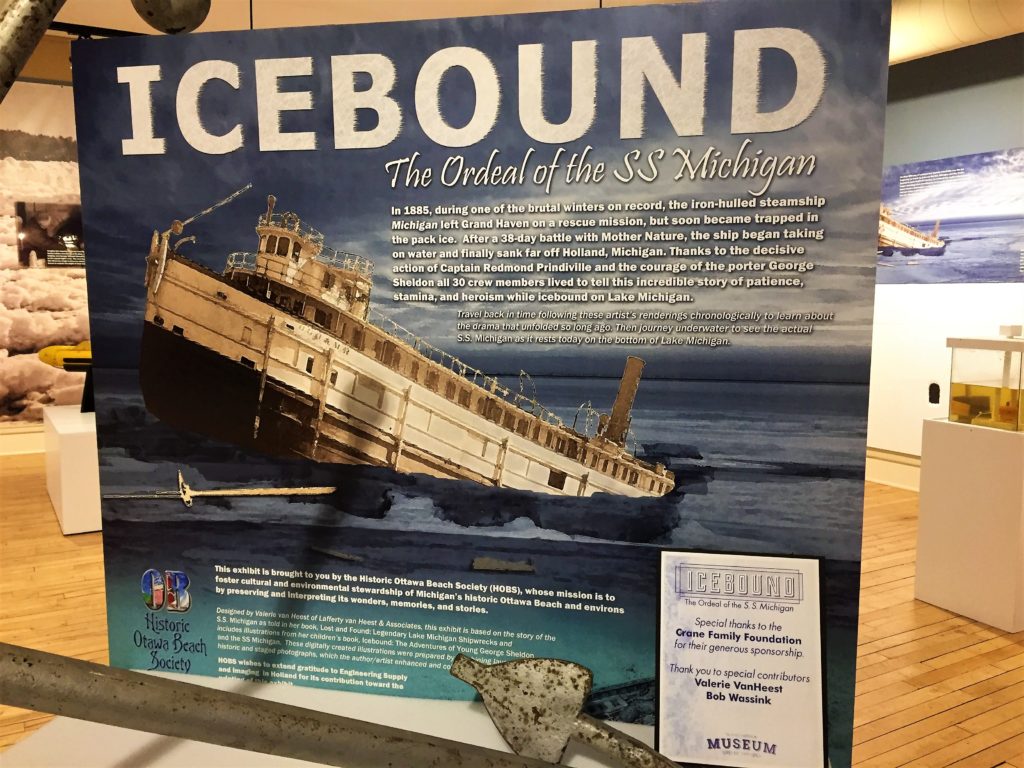
One of the exhibit’s designers is author Valerie Van Heest, who wrote the children’s book, Icebound: The Adventures of Young George Sheldon and the S.S. Michigan. Her drawings are used throughout the exhibit to help bring the story to life.
There is also information about other shipwrecks found in Lake Michigan and the efforts to locate and recover them. Icebound will be on display at Tri Cities Historical Museum through September 2019. We don’t want to miss it!
Know Before You Go
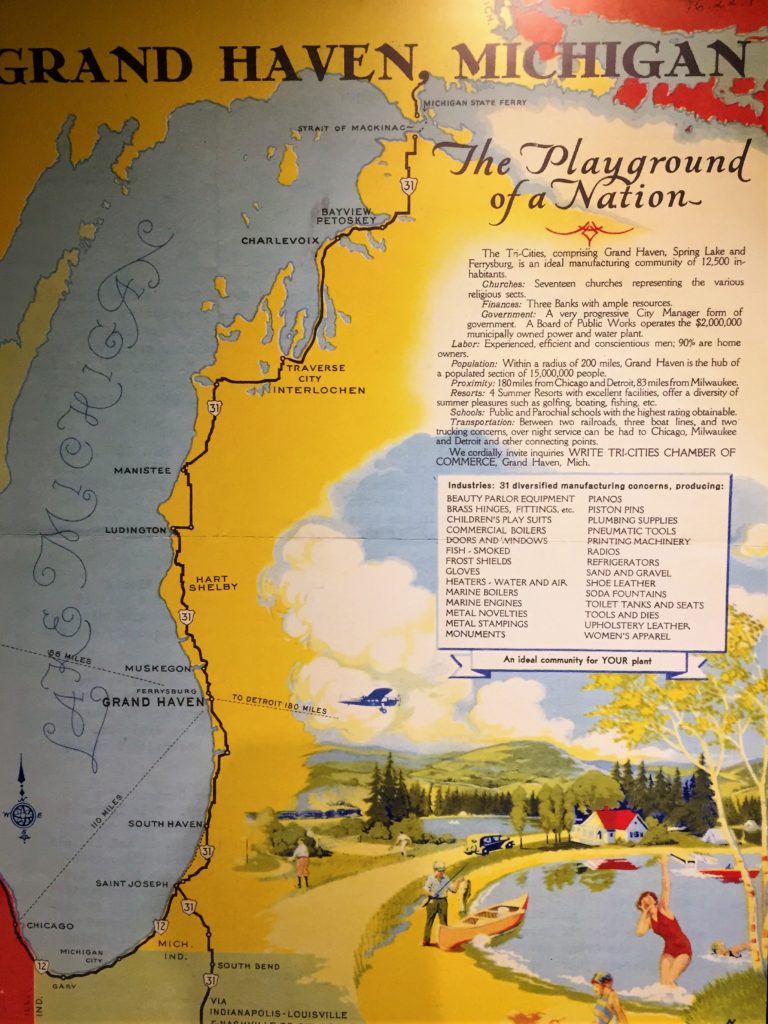
Tri-Cities Historical Museum is located inside the Akeley Building and is open Tuesday through Sunday with differing hours for summer and winter. Admission is FREE and donations are greatly appreciated.
The museum has a gift shop which offers a variety of items about Michigan history, as well as handmade items from local artisans. All profits go directly to the museum to help support their mission.
Our family had a wonderful time learning and “living” history at the Tri-Cities Historical Museum, and perhaps you will too! We look forward to stopping in again sometime.
Read about our other adventures in Michigan:
- Outdoor Discovery Center (FREE), Holland, MI
- SEA LIFE Aquarium, Auburn Hills, MI
- Legoland Discovery Center, Auburn Hills, MI
- Top 10 Things to Do in Muskegon, Michigan
- Quality Inn & Suites Hotel, Muskegon, MI
- Jubliee Cottage Visit, Grand Haven, MI
- Zehnder’s Splash Village Indoor Water Park & Hotel, Frankenmuth, MI
Be sure to check out our Top 30 Gift Ideas for Travelers. It is full of unique ideas to give to those in your life who love to travel… or to add to your own personal carry-on. We’ve even included the one item we won’t go to Disney without… it might surprise you!


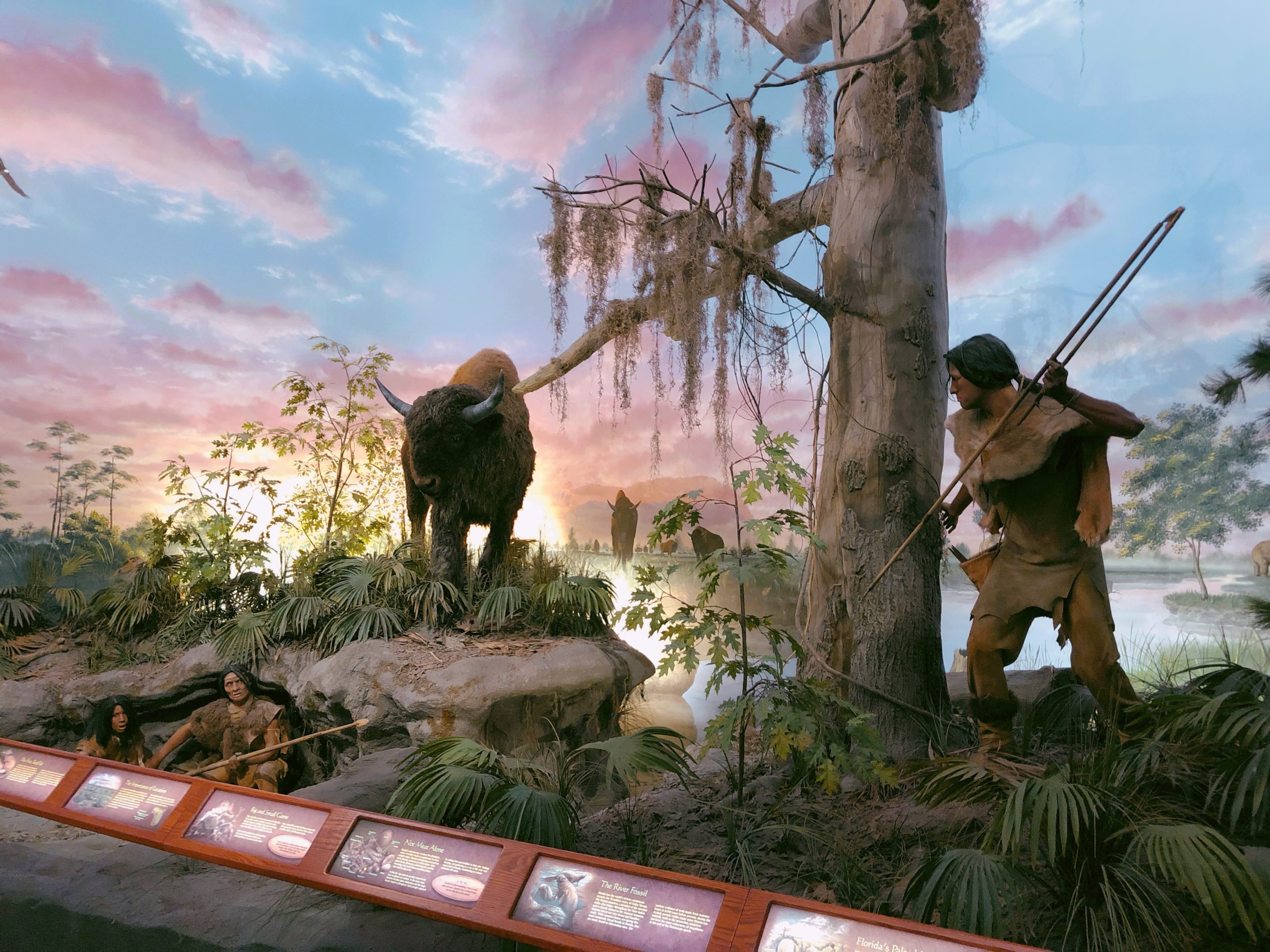
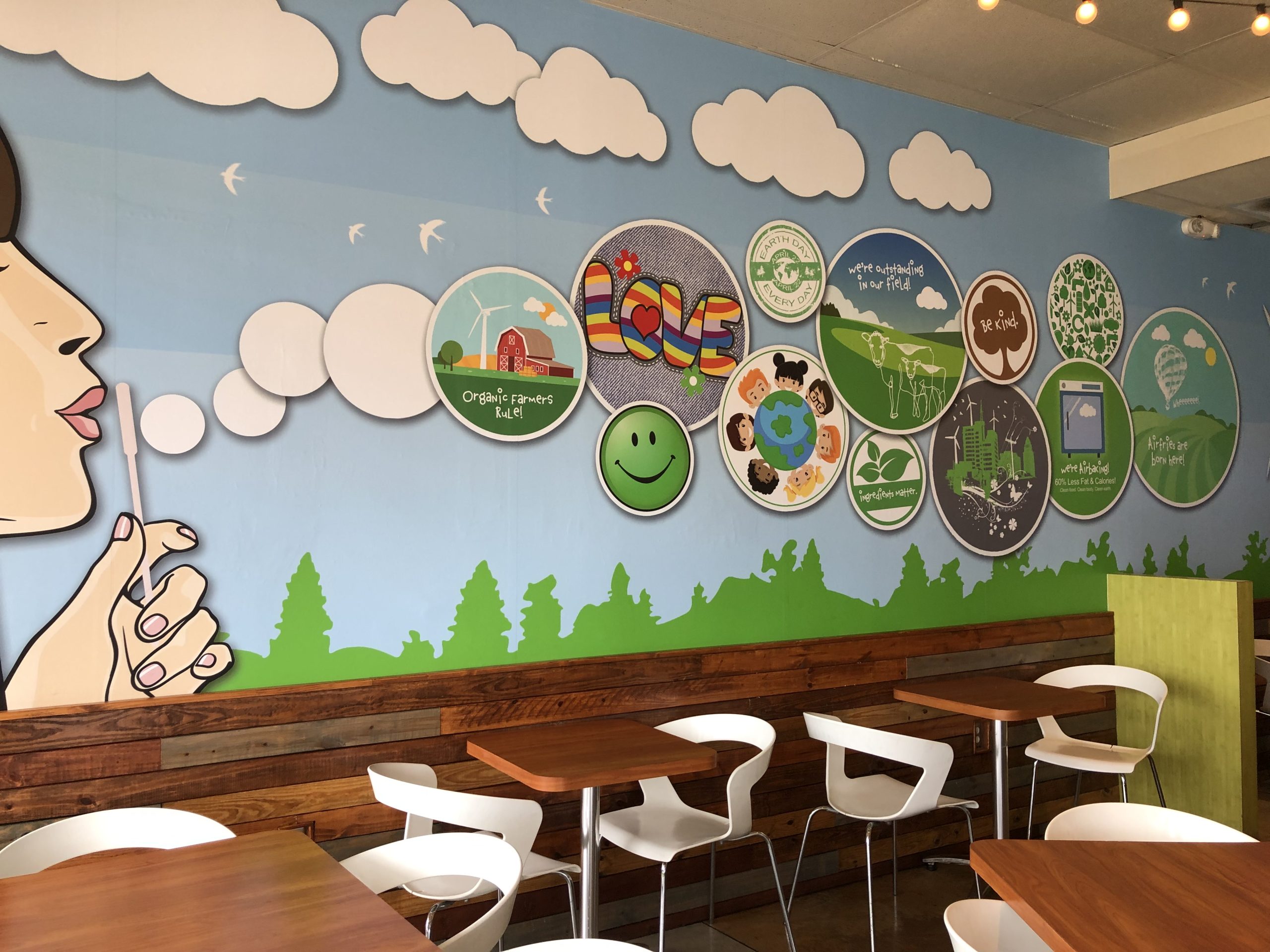
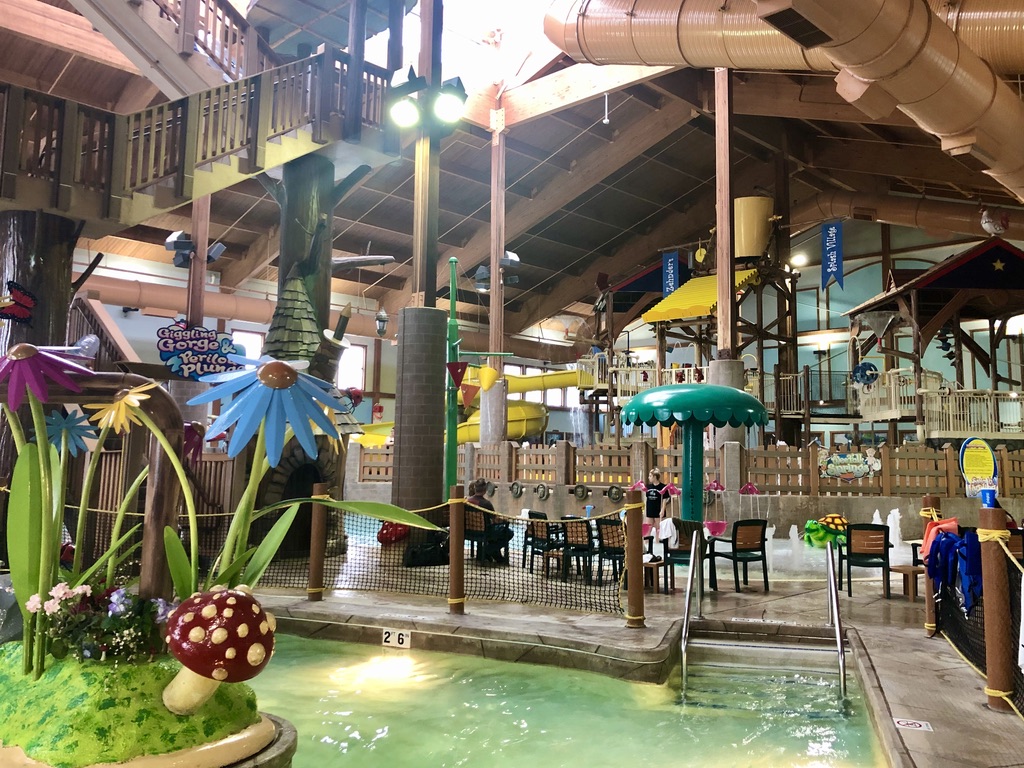
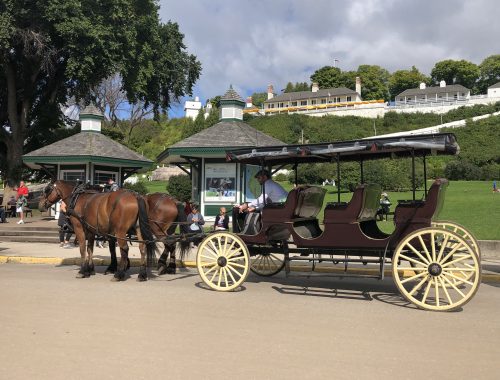
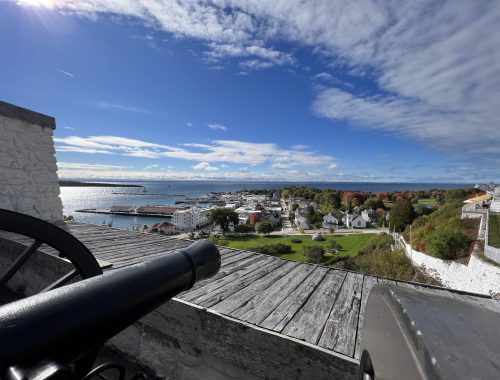
30 Comments
Shirley
Very cool! I love history and learning about our country’s past. This look like a great museum!
Charlene
We do too! Our kids really had fun exploring and learning. Such a cute museum.
Heather
This looks great. I love to explore places like this.
Charlene
Thank you! Of all the times we have visited Grand Haven, last summer was the first we’d discovered Tri-Cities Historical Museum. Glad we did!
Amanda Howe
We love history! This will go on my list of places to visit when we are in MI. Thanks for sharing!
Charlene
Of course and we hope you get to visit them soon. Happy travels!
Tricia Snow
I love museums …. and this looks like a cool place to vacation since it is on the coast of Lake Michigan!
Charlene
The Grand Haven area is so charming and Tri-Cities Historical Museum definitely added to it. Can’t wait until summer and the beach!
Shannon Delaney
I enjoyed reading about this place. I love Michigan with it’s amazing trees and history. Thank you for sharing.
Charlene
Thank you. Michigan is quite a beautiful state for sure and yes… the trees are gorgeous, especially in the autumn. We always look forward to exploring the area!
Lisa Manderino
Michigan, I think I need to come visit!
Charlene
I think Michigan likes this plan!
kmf
Love learning the history of places I visit…thanks for sharing!
Charlene
Absolutely, we do too! Yay for history!
Jennifer - Me and My Traveling Hat
This is one state I have not visited yet. But when I head there you have given me a few ideas in places to visit. Thank you for sharing.
Charlene
We are happy to share and hope you get to visit the mitten state soon. Happy travels!
Kristin
Looks like a great little town to visit. The museum sounds amazing. Good job with the pics, dad!!
Charlene
Aw thanks, I’ll be sure Dad gets the message! We love Grand Haven and this museum was the perfect way to get to know it better.
Briana
That place looks so comfy!
Charlene
It was SO cute!
Missy
Such a great museum. I appreciated the “Know Before You Go” segment.
Charlene
Thank you! We look forward to being able to visit them again.
Michele
Maybe its because we homeschool, but we love adding museums like this to our travels! That may be why history is Payton’s favorite subject. Great read that I pinned for when we make it to Michigan!
Charlene
We couldn’t agree more…we LOVE museums. Glad to hear Payton has an interest in history, that definitely makes it more fun to teach. Hope you get to visit Michigan and Tri- Cities Historical Museum soon!
jen
My kind of post! Love it! I adore a good museum!
Charlene
Aw thank you! Nothing like a well done museum!
Lara
What a smart idea to relate the items in the museum to the story you were reading with the kids. That can really get them to better understand how things were in that time. Good idea!
Charlene
Thank you… it actually didn’t hit me, until we were at the museum, that a lot of things pertained to what we were reading at home. One of those unplanned things that makes me look really on top of it, lol. I’ll take it!
Hera
Never been to Grand Haven, only Detroit. This looks like a neat place to visit if we ever find ourselves in GH. Detroit has a good sense of community and it seems like GH does too.
Charlene
It’s been so long since we’ve visited Detroit… I think we are way overdue! Glad to hear the sense of community is doing well there. Hope you get to spend some time in Grand Haven soon. Happy travels!